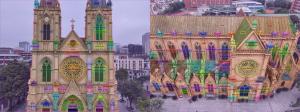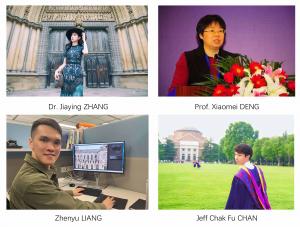
Next-Gen Digital Twin and AI Breathe New Life into Architectural Heritage Preservation:Innovative Research Released
The digitalization and intelligentization of heritage buildings provide a new direction for the dissemination of knowledge and value of heritage buildings. The research team consisted of Dr. Jiaying Zhang, Zhenyu Liang, and Jeff Chak Fu Chan from the Hong Kong University of Science and Technology cooperated with Prof. Xiaomei DENG from Tsinghua University have jointly released innovative research outcomes: In the absence of structured data, a digital twin intelligent agent for heritage building preservation has been constructed using Multimodal Large Language Models (MLLMs) and 3D Gaussian Splatting (3DGS). Based on 3DGS technology, an efficient and detailed digital model reconstruction of heritage buildings has been realized, accurately restoring real scenes of heritage buildings, addressing the issue of lightweighting complex building three-dimensional models, and supporting virtual visits. Traditionally, converting unstructured data into structured data required significant manpower, especially for heritage buildings, whose data had to be processed by domain experts. Whereas, the proposed innovative digital twin approach can accurately present the target building with just a small set of data samples and further integrate semantic information into 3D scenes, thereby achieving efficient visualization, digital twin construction, and data management. The proposed strategy can easily convert architectural geometric models into 3D component models with rich semantics, facilitating the cataloging and consulting of heritage data, and supporting navigation and queries in 3D scenes. This achievement has been validated on the Sacred Heart Cathedral in Guangzhou. The method proposed for historical building component identification verification has a high accuracy rate of up to 95.6%. Furthermore, the team has built an interactive intelligent agent for heritage building digital models using large language model AI. This digital twin intelligent agent can converse and interact with users, who only need input vague query instructions for the digital model to highlight the corresponding components and present relevant information. This achievement enhances the documentation and querying capabilities of components in heritage digital twins, making it easier for users to navigate and retrieve information about heritage, allowing the public to gain a deeper understanding of the essence of heritage buildings.
The advent of large language model AI has brought revolutionary changes to many fields, including the study and dissemination of ancient architecture knowledge. Previously, acquiring knowledge about heritage buildings required extensive learning and literature review. Now, by directly inputting related data seen on-site to the large model AI, professional-level recognition and analysis of heritage building components can be easily achieved. Through interaction with the large model AI, the public can learn about the historical background, architectural style, and cultural significance of heritage buildings. This technology lowers the threshold for professional domain knowledge, injects new vitality into the field of heritage building preservation, promotes the dissemination and sharing of knowledge, and enables more people to participate in the meaningful work of cultural preservation and inheritance of heritage.
Research Team
Dr. Jiaying ZHANG entered University College London in 2016 to pursue a master's degree in Sustainable Heritage, then conducted research in intelligent architecture and engineering at Tsinghua University and the Hong Kong University of Science and Technology. She has been engaged in the study of heritage building preservation theory, methods, and policies for many years. Dr. Zhang's research activities span different climatic regions including Mainland China, Hong Kong SAR, London UK, and Malta. The digital twin intelligent agent for heritage building created by Dr. Zhang not only supports the current status preservation of heritage buildings but also provides an accurate database for future renovation and emergency management of heritage buildings.
Zhenyu LIANG, a doctoral student at the Hong Kong University of Science and Technology, graduated from South China University of Technology with a bachelor's degree. His main research direction includes the construction of lightweight digital models, specializing in using technologies such as images and point clouds to reconstruct three-dimensional models of heritage buildings and other complex scenes, and further generating semantically rich informational models such as BIM through artificial intelligence technology.
Jeff Chak Fu CHAN, a master's student at the Hong Kong University of Science and Technology, graduated from Tsinghua University with a bachelor's degree. His current research direction is the development and application of multimodal large language models in the construction industry, specializing in training multimodal large models for industry scenarios with limited data, achieving visualization and intelligentization of architectural digital twins, and successfully building prototypes in the field of heritage building preservation.
Cooperated Professor
Professor Xiaomei DENG of Tsinghua University: Led the formulation of the sustainable development strategic plan for the Hengshui Lake National Nature Reserve in Hebei, Adviser of Ministry of Housing and Urban-Rural Development of the People’s Republic of China, vice-chairman of the Academic Committee of the China Construction Supervision Association, member of the China Construction Industry Association, and member of the "Expert Group on Fighting and Preventing Corruption in Prosecutorial Organs" of the Beijing Procuratorate.
JIAYING ZHANG
The Hong Kong University of Science and Technology
jiayingzhang@ust.hk
EIN Presswire does not exercise editorial control over third-party content provided, uploaded, published, or distributed by users of EIN Presswire. We are a distributor, not a publisher, of 3rd party content. Such content may contain the views, opinions, statements, offers, and other material of the respective users, suppliers, participants, or authors.






